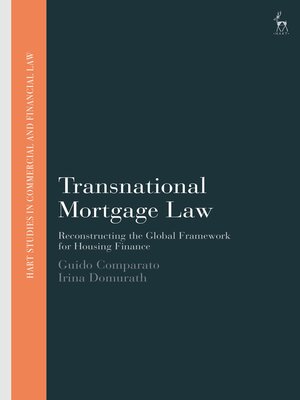Transnational Mortgage Law
ebook ∣ Reconstructing the Global Framework for Housing Finance · Hart Studies in Commercial and Financial Law
By Guido Comparato

Sign up to save your library
With an OverDrive account, you can save your favorite libraries for at-a-glance information about availability. Find out more about OverDrive accounts.
Find this title in Libby, the library reading app by OverDrive.



Search for a digital library with this title
Title found at these libraries:
| Library Name | Distance |
|---|---|
| Loading... |
This book uncovers and reconstructs the growing body of legal principles and rules governing mortgages that have been developed by different transnational institutions and actors.
It shows how mortgages have evolved from a type of real security commonly used to facilitate lending by mitigating credit risk, to a transferable commodity with the potential to affect international financial stability and consumer welfare. In doing so, the book reveals the emergence of new policy objectives and rationales for regulation that have led to changes in the structure and functions of mortgage laws. Characterising this development as a type of transnational law, the book highlights the paradigm shifts in the law of residential mortgages brought about by their increasing global relevance. The analysis reveals tensions between the goals of risk mitigation, financial stability, consumer protection and housing justice.
The result is an innovative analysis at the intersection of contract law, property law and international financial regulation. The book portrays transnational mortgage law as a complex field governed by a plurality of socially and economically relevant but potentially conflicting goals and principles.
It shows how mortgages have evolved from a type of real security commonly used to facilitate lending by mitigating credit risk, to a transferable commodity with the potential to affect international financial stability and consumer welfare. In doing so, the book reveals the emergence of new policy objectives and rationales for regulation that have led to changes in the structure and functions of mortgage laws. Characterising this development as a type of transnational law, the book highlights the paradigm shifts in the law of residential mortgages brought about by their increasing global relevance. The analysis reveals tensions between the goals of risk mitigation, financial stability, consumer protection and housing justice.
The result is an innovative analysis at the intersection of contract law, property law and international financial regulation. The book portrays transnational mortgage law as a complex field governed by a plurality of socially and economically relevant but potentially conflicting goals and principles.







